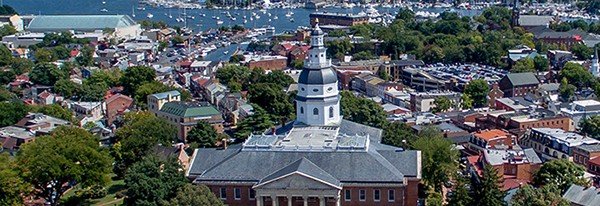Date:
A crisp autumn evening is the perfect time to walk through a historic neighborhood in Annapolis. For the past 29 years, the experience has been made even better when the doors to some of Annapolis’s most beautiful homes were opened and you were welcomed inside. Although the COVID-19 health crisis threatened to end this fall tradition, Historic Annapolis is pleased to announce the 29th Annual Annapolis by Candlelight will continue this winter in a new virtual format.
Beginning April 23, 2021, guests will be able to gather with a small group of friends and family and virtually tour several of the area's most historically significant buildings. Tickets will allow viewers to “visit" the sites at their leisure from April 23 through March 7. Tickets are $35 General Admission and $30 for Historic Annapolis Members and Volunteers and may be purchased online at www.annapolis.org or by calling 410.267.7619. Guests may also take advantage of a membership special, available to new members only, that offers a Historic Annapolis Sponsor Level membership and one complimentary access to virtual tour for $100 (value of $135).
The tour will take advantage of its virtual format by including sites outside of the Historic District and some building spaces not usually open to visitors. Highlights of the tour include:
Acton Hall
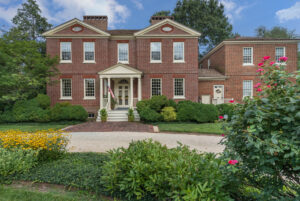 This Georgian manor home overlooking Spa Creek was built by John Hammond in the early 1770s. The Duvall and Murray families owned Acton Hall through much of the 19th century, and the streets and lots of the Murray Hill neighborhood were carved out of the original Acton land grant in the 1890s. After falling into serious disrepair by the 1970s, Acton Hall was restored by preservation-minded owners.
This Georgian manor home overlooking Spa Creek was built by John Hammond in the early 1770s. The Duvall and Murray families owned Acton Hall through much of the 19th century, and the streets and lots of the Murray Hill neighborhood were carved out of the original Acton land grant in the 1890s. After falling into serious disrepair by the 1970s, Acton Hall was restored by preservation-minded owners.
Whitehall
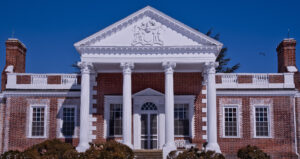 Whitehall was built beginning in 1764 for Governor Horatio Shape, the provincial governor of colonial Maryland. In 1769, the site became Sharpe's primary residence after he was relieved as governor by Robert Eden. In 1773, Sharpe departed for England, leaving his property in the care of John Ridout, his friend and secretary. The site remained in the Ridout family until 1896. In the mid-20th century, Whitehall was restored by Charles Scarlett, Jr., and it still remains in the Scarlett family through their Brandywine Foundation.
Whitehall was built beginning in 1764 for Governor Horatio Shape, the provincial governor of colonial Maryland. In 1769, the site became Sharpe's primary residence after he was relieved as governor by Robert Eden. In 1773, Sharpe departed for England, leaving his property in the care of John Ridout, his friend and secretary. The site remained in the Ridout family until 1896. In the mid-20th century, Whitehall was restored by Charles Scarlett, Jr., and it still remains in the Scarlett family through their Brandywine Foundation.
McDowell Hall, St. John's College
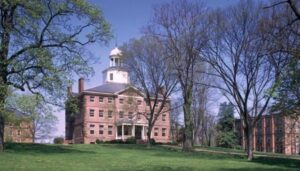 Construction on this building began in 1744 after colonial Maryland’s legislature authorized funding for an official residence for Governor Thomas Bladen. The Governor's home was planned as one of the largest and most elaborate houses in all the colonies, but political funding disputes left the unfinished, unroofed structure with a mocking nickname: “Bladen’s Folly.” In 1784, the newly chartered St. John's College took over the building and saw to its completion.
Construction on this building began in 1744 after colonial Maryland’s legislature authorized funding for an official residence for Governor Thomas Bladen. The Governor's home was planned as one of the largest and most elaborate houses in all the colonies, but political funding disputes left the unfinished, unroofed structure with a mocking nickname: “Bladen’s Folly.” In 1784, the newly chartered St. John's College took over the building and saw to its completion.
Patrick Creagh House
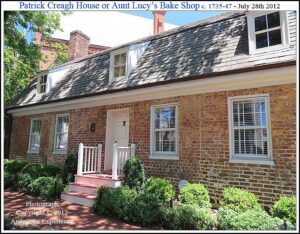 Patrick Creagh built his modest Georgian home between 1735 and 1747. Creagh was also the builder of "Bladen's Folly," the Old Treasury building on State Circle, and the colonial prison near City Dock. During the early 19th century, a free African American couple, John and Lucy Smith, lived here, first as renters, and then as owners. John ran a transport business out of a livery stable behind the house, while "Aunt Lucy" operated a successful baking and catering business on Main Street.
Patrick Creagh built his modest Georgian home between 1735 and 1747. Creagh was also the builder of "Bladen's Folly," the Old Treasury building on State Circle, and the colonial prison near City Dock. During the early 19th century, a free African American couple, John and Lucy Smith, lived here, first as renters, and then as owners. John ran a transport business out of a livery stable behind the house, while "Aunt Lucy" operated a successful baking and catering business on Main Street.
Primrose Hill
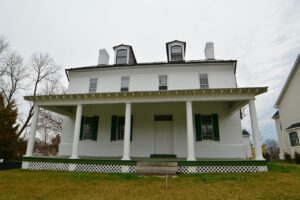 Situated on a high hill overlooking the headwaters of Spa Creek, on land patented in the earliest years of English settlement on the Severn River, Primrose was one of the few colonial plantations on the outskirts of Annapolis that continued to be farmed well into the 20th century. The brick mansion that remains today was home to members of the extended Young, Woodward, and Hesselius clans for more than sixty-five years. Among the men who lived there, albeit briefly, in the eighteenth century, were Maryland legislator and merchant Henry Woodward, celebrated artist John Hesselius, and artist and Revolutionary officer Edmund Brice. But it was the women of Primrose, Rebecca Holdsworth Young and her daughter Mary Young Woodward Hesselius, who kept farm and family together for all of that time.
Situated on a high hill overlooking the headwaters of Spa Creek, on land patented in the earliest years of English settlement on the Severn River, Primrose was one of the few colonial plantations on the outskirts of Annapolis that continued to be farmed well into the 20th century. The brick mansion that remains today was home to members of the extended Young, Woodward, and Hesselius clans for more than sixty-five years. Among the men who lived there, albeit briefly, in the eighteenth century, were Maryland legislator and merchant Henry Woodward, celebrated artist John Hesselius, and artist and Revolutionary officer Edmund Brice. But it was the women of Primrose, Rebecca Holdsworth Young and her daughter Mary Young Woodward Hesselius, who kept farm and family together for all of that time.
The virtual tour will feature historical overviews by HA's Senior Historian Glenn E. Campbell, and interviews with homeowners and preservation experts, including Marcia Miller from the Maryland Historical Trust and Willie Graham, Architectural Consultant and former Curator of Architecture at Colonial Williamsburg.
Visitors will be able to see how 21st-century Annapolitans care for, live in, and make use of historic buildings. This tour is a fantastic reminder of the rich architectural and cultural heritage of Maryland’s capital city and showcases the many benefits of effective historic preservation.
“Each year, I am amazed by the beautiful houses and public buildings on this tour,” says Robert Clark, President and CEO of Historic Annapolis. “There truly are so many architectural and historical gems in Annapolis and Anne Arundel County. We hope the virtual format will allow us to continue to reach our core audience, but also introduce Annapolis to potential visitors near and far.”
The full tour program will be available at www.annapolis.org (http://annapolis.org) by Friday, April 16, 2021, and instruction on accessing the online tour will be emailed to registrants on April 23, 2021.


